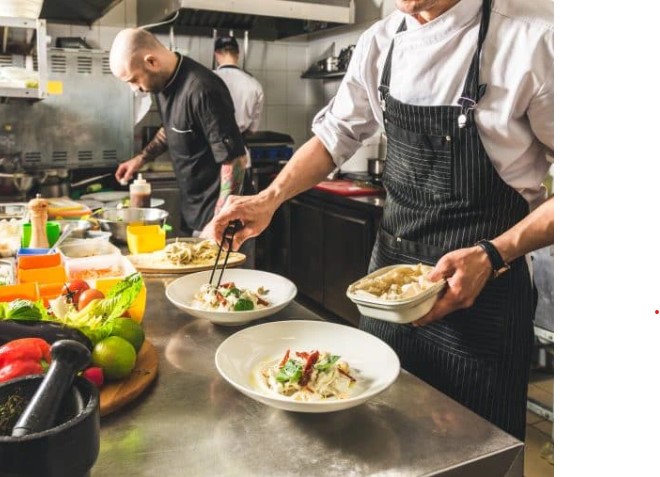This module describes the skills, knowledge and attitude required in preparation of stocks, soups and derivation sauces. Trainees will also be able to select tools and equipment for preparation of stocks, soups and sauces, select ingredient, how to prepare stocks, soups and sauce, select methods of cooking ,consistence of soups and
sauces plating and garnishing. Once this module is well covered, trainees will be able to differentiate the preparation of stocks, soups and sauces.
- Teacher: Joseph HAKUZIMANA

•This module describes the performance outcomes, skills and competencies required by the learner to manage, apply, supervise, monitor and implement kitchen hygiene and sanitation in the kitchen and hospitality industry.
•The learner will be able to Supervise kitchen hygiene, Manage personal hygiene of the food handler and Monitor kitchen hygiene and safety.
- Teacher: HABUMUREMYI Faustin

This module describes the skills, knowledge and attitudes required to monitor hygiene
and sanitation best practices at workplace, describe communicable and non
communicable diseases, prevent gender based violence and sustain individual health
and safety at workplace.
- Teacher: Esperance KAMPIRE

Choosing Fruits:
- Seasonality: Choose fruits that are in season for the best flavor and value.
- Ripeness: Select fruits that are ripe but not overripe. Look for good color, a slight give to the touch, and a pleasant aroma.
- Variety: A mix of colors, textures, and flavors makes for a more interesting fruit salad.
2. Washing Techniques
Proper washing is crucial for removing dirt, pesticides, and bacteria from fruits.
- Before Cutting: Always wash fruits before you cut them. This prevents transferring contaminants from the peel to the flesh.
- Running Water: The best way to wash most fruits is under cold, running water. Rub the fruit gently to remove any dirt.
- Leafy Greens: For leafy greens like lettuce or spinach (sometimes used in fruit salads), separate the leaves and wash them thoroughly in a bowl of cold water.
- Avoid Soap: Generally, avoid using soap or detergent to wash fruits, as they can leave a residue. Plain water is usually sufficient. Specialized fruit and vegetable washes are available but not always necessary.
- Drying: After washing, pat the fruit dry with a clean towel or paper towel. This helps prevent bacterial growth.
3. Fruit Peel and Cut Techniques
Different fruits require different peeling and cutting techniques.
- Peeling:
- Vegetable Peeler: Best for thin-skinned fruits like apples, carrots (if using in a salad), or cucumbers.
- Paring Knife: Useful for more delicate peeling or removing blemishes.
- Chef's Knife: Used for thicker-skinned fruits or when larger pieces are needed.
- Cutting:
- Dicing: Cutting into small, uniform cubes.
- Slicing: Cutting into thin, flat pieces.
- Chopping: Cutting into irregular pieces.
- Segments: Removing the individual sections of citrus fruits.
- Safety: Always use a sharp knife and cut on a stable cutting board. Keep your fingers away from the blade and cut away from your body.
Preventing Browning:
Some fruits, like apples and bananas, brown quickly after being cut due to oxidation. To prevent this:
- Acidic Wash: Dip the cut fruit in a mixture of lemon or lime juice and water.
- Airtight Storage: Store cut fruits in an airtight container in the refrigerator.
- Teacher: NYIRANGIRIMANA Immaculee
This module describes the skills, knowledge and attitude acquired by the learner to plan and prepare a dish from local ingredients like potatoes, beans, plantains, cassava, peas, millet, sorghum, sweet potatoes, meat, fish, vegetables, legumes and tropical fruits such as avocado, bananas, mango, pineapple, passion fruits. The module contents are grouped into three learning unities namely to Plan for African dishes preparation, perform African dishes preparation activities and present African dishes. The module leads a learner to characterize African cuisine and prepare professionally a range of African dishes.
- Teacher: UWAMAHORO Euphrasie Raissa

This module describes the skills, knowledge and right attitudes required to match the learning process with occupation, develop action plan to meet occupation standardsand relate occupation with the labor market demand. This module is intended fortrainees pursuing Diploma in Culinary Arts trades. The trainees will be able to identify the occupation and its learning processes. They will also be able to integrate in theworking environment, set out the goals to perform the occupation and self-assessment.This module encourages greater motivation and, subsequently, a better integration ofvarious learning.
The trainees will be able to independently develop a comprehensiveand clear vision of the occupation and training programme at professional level.
- Teacher: Vianney GASARASI

This module aims at equipping the learner with skills, knowledge and attitudes required to apply professional ethics that facilitate effective learning at the workplace. After completion of this module, learner will be able to apply ethics, respect Restaurant ethics and apply responsibility as well.
- Teacher: Vianney GASARASI


